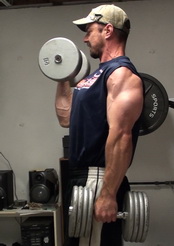The deadlift has three major sticking points...off the floor, at the top lockout and just below the knees.
This really unique setup is going to allow you to train that EXACT spot just below the knees with increased weight right at that spot.
Quite often, if that is your biggest sticking point, your 1 rep max will be limited to what you can power off the floor to blast THROUGH that sticking point.
That's not wrong but if you want to REALLY maximize your strength, you need to train your weak points so they're no longer weak.
This method really forces your body to re-engage and grind the weight up and not completely rely on momentum to blast through it.
To do this Kettlebell-Hanging Deadlift, you'll need two bars, a heavy kettlebell and a thick band.
I'm using a thick black band and a 90 lb kettlebell with 225 lbs on the bar. If you don't have a single thick one, you can use a pair of medium bands, too (or more smaller bands)...that'll work just as well as a single band.
Set a bar in the rack at about belly button height, pulled up against the uprights of the rack. You could also use the end of a Smith machine bar for this, too.
Before you put weight plates on your deadlift bar, loop the band around it. THEN put plates on.

Now put the other end of the band through the handle of the kettlebell.

Next, put the other end of the band over the bar that's on the rack. You'll need to shift the bar over a bit then tilt it down, then put the band over it.


Then put the bar back on the rack rails.

Move the bar away from the rack a few feet. The kettlebell should be right up close to the bar at the bottom.

Now the fun begins...
You can use grip assistance for this (I like to, so I can do double overhand grip) or not. No big deal either way...I like to take grip out of the equation when working on sticking points, though.
Set up exactly as you normally would for a deadlift.

Lift the bar off the floor with POWER.
The first few inches will feel like a speed deadlift.
Right when the bar is just below the knees, the kettlebell should come up off the ground (you may need to adjust the band strength or kettlebell weight to achieve this... I found the thick black band with a 90 lb kettlebell to be just perfect).

At this point, you suddenly have 90 more pounds to lift...right at that exact sticking point.
Keeping attempting to power through this point strongly...it'll be come a grinding rep, which is exactly what we're looking for.
You're training your body to push through that sticking point while you're building strength right at that sticking point.
Now, in addition to that extra weight, you also get DIRECTIONAL resistance with the band as you come to the top lockout.
You have to lockout against that diagonal band resistance (this actually strengthens TWO sticking points in every rep).

Lower back down to the ground, reset then go again.
I recommend sticking to around 3 to 6 reps with this method. It's designed for building strength, so we don't want to go too light and dilute this benefit.
Definitely go lighter than you think you'll need to the first time you do this one. I can easily deadlift 315 in a regular lift but this sudden increase in resistance really challenged me.
You can play with the kettlebell weight and the band strength to determine where the maximum loading hits you.
And if you don't have kettlebells, you could potentially use bumper plates (I didn't test that but I think it would work fairly well).
Overall, this one is a BEAST for directly targeting that below-the-knee sticking point. I like it a lot and I can feel it has massive potentially for improving deadlift strength.
Are you 40...50...60 or even 70+ years old and want to build muscle and strength like you did 20 years ago?
If you feel like you're fighting a losing battle, you're ready to discover the REAL secret to REVERSING muscle loss due to aging...
*** You need to train the body systems that SUPPORT your muscle mass, not just the muscle itself. ***
These underlying support systems diminish as you age, which is why you lose muscle as you get older no matter how hard you train... but with strategic training, these systems can be regenerated.
Share This Page...
Want More Strength-Building Techniques and Programs?
You'll find them here...



